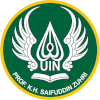PRE-ISLAMIC CULTURE AND RELIGION:
THE ARABIAN EARLY SOCIAL CHANGES UNDER ISLAM
DOI:
https://doi.org/10.24090/ibda.v17i1.2747Keywords:
the Arabs; pre-Islamic society; Islamic teaching; Kabilah; education.Abstract
Pre-Islamic Arab society is known as the people who inclined towards practicing racism, feudalism and patriarchy values. The pre-Islamic period was known to the Arabs as the period of living ignorant people. However, revolutionary momentum occurred after the emergence of Islam in the desert region. Radical Islam could change the Arab social order to the point where human values almost disappeared. That was thebeginning of learning society through educational values consistently with the Islamic teachings. This article provides sufficient evidence to examine how the educational knots began to disappear in the land ofHijaz. By examining the demographics of the culture of pre-Islamic Arab society, this article also attempts to take the segmentation of society as the basis for analyzing the emergence of Islamic teachings through theestablishment of the learning societies initiated by Prophet Muhammad (P.B.U.H).Downloads
Download data is not yet available.
References
Adlan, Abdul Jabbar. 1995. Dirasat Islamiyyah. Surabaya: Anika Bahagia Offset,
Baram, Amatzia. 1997. “Neo-Tribalism in Iraq: Saddam Hussein's Tribal Policies 1991-96.†International Journal of Middle East Studies, vol. 29, no. 1, 1997, pp. 1–31. JSTOR, www.jstor.org/stable/163849
al-Baqi, Muhammad Fuad Abd. 1986. al-Mu’jam al-Mufahras li Alfadz al-Quran al-Karim, 1st print. Dar al-Fikr
Amir Ali, Syed. 1978. Api Islam. Jakarta: Bulan Bintang
Bailey, G.N., Flemming, N. C., King, G. C. P, Lambeck, K. Momber, G., Moran, L.J. Al-Sharekh, A., and Finzi, C.V. 2007. Coastlines, Submerged Landscapes, and Human Evolution: The Red Sea Basin and the Farasan Islands, Journal of Island & Coastal Archaeology, 2:127–160, 2007,
Hitti, Philip K., 1974. History of Arabs from Earliest Times to the Present, eds. X. London: The Macmillan Press,
Istadiyantha, 2016. The Ideology of Islamic State of Iraq and the Syria and Al-Qaeda After the Arab Spring and Its Impacts in Southeast Asia. Advanced Science Letters, (22), 12, December 2016, pp. 4418-4421(4). DOI: https://doi.org/10.1166/asl.2016.8172
Jawad, Haifaa A., 1989. The Right of Women in Islam; An Authentic Approach,1st print. New York: S.T. Martin’s Press
al-Khurbuthuli, Ali Husni, 1959. Ma’a al-‘Arab (I): Muhammad wa al-Qaumiyah al-‘Arabiyah, 2nd print. Kairo: al-Mathbu’ah al-Haditsah
Lapidus, Ira M., 1995. A History of Islamic Societies, print. X. Cambridge: Cambridge University Press,
Leboun, Gustav,. No Year. Hadlarah al-‘Arab. Kairo: Mathba’ah Isa al-Babi al-Halabi
Montgomery, Watt, W. 1969. Muhammad: Prophet and Statesman, 2nd print. Oxford: Oxford University Press
Montgomery, Watt, W. 1988. Muhammad’s Mecca; History in the Quran. Edinburgh: Edinburgh University Press
Taylor, Jane. 2001.Petra and the Lost Kingdom of the Nabataeans. London, United Kingdom: I.B.Tauris. Ed.
Wafi, Ali Abd al-Wahid, 1984. al-Musawah fi al-Islam, [Transl. Anshari Sitanggal and Rosichin]. Bandung: al-Ma’arif
al-Wahidi, Abu al-Hasan ‘Ali ibn Ahmad. No Year. Asbab al-Nuzul. Kairo: Maktabah al-Da’wah.
Yatim, Badri, 1997. Sejarah Peradaban Islam. Jakarta: Raja Grafindo
al-Zayyat, Ahmad Hasan, No Year. Tarikh al-Adab al-‘Arabi. Beirut: Dar al-Tsaqafah
Ali, Syed Amir, 1978. Api Islam. Jakarta: Bulan Bintang
Baram, Amatzia. 1997. “Neo-Tribalism in Iraq: Saddam Hussein's Tribal Policies 1991-96.†International Journal of Middle East Studies, vol. 29, no. 1, 1997, pp. 1–31. JSTOR, www.jstor.org/stable/163849
al-Baqi, Muhammad Fuad Abd. 1986. al-Mu’jam al-Mufahras li Alfadz al-Quran al-Karim, 1st print. Dar al-Fikr
Amir Ali, Syed. 1978. Api Islam. Jakarta: Bulan Bintang
Bailey, G.N., Flemming, N. C., King, G. C. P, Lambeck, K. Momber, G., Moran, L.J. Al-Sharekh, A., and Finzi, C.V. 2007. Coastlines, Submerged Landscapes, and Human Evolution: The Red Sea Basin and the Farasan Islands, Journal of Island & Coastal Archaeology, 2:127–160, 2007,
Hitti, Philip K., 1974. History of Arabs from Earliest Times to the Present, eds. X. London: The Macmillan Press,
Istadiyantha, 2016. The Ideology of Islamic State of Iraq and the Syria and Al-Qaeda After the Arab Spring and Its Impacts in Southeast Asia. Advanced Science Letters, (22), 12, December 2016, pp. 4418-4421(4). DOI: https://doi.org/10.1166/asl.2016.8172
Jawad, Haifaa A., 1989. The Right of Women in Islam; An Authentic Approach,1st print. New York: S.T. Martin’s Press
al-Khurbuthuli, Ali Husni, 1959. Ma’a al-‘Arab (I): Muhammad wa al-Qaumiyah al-‘Arabiyah, 2nd print. Kairo: al-Mathbu’ah al-Haditsah
Lapidus, Ira M., 1995. A History of Islamic Societies, print. X. Cambridge: Cambridge University Press,
Leboun, Gustav,. No Year. Hadlarah al-‘Arab. Kairo: Mathba’ah Isa al-Babi al-Halabi
Montgomery, Watt, W. 1969. Muhammad: Prophet and Statesman, 2nd print. Oxford: Oxford University Press
Montgomery, Watt, W. 1988. Muhammad’s Mecca; History in the Quran. Edinburgh: Edinburgh University Press
Taylor, Jane. 2001.Petra and the Lost Kingdom of the Nabataeans. London, United Kingdom: I.B.Tauris. Ed.
Wafi, Ali Abd al-Wahid, 1984. al-Musawah fi al-Islam, [Transl. Anshari Sitanggal and Rosichin]. Bandung: al-Ma’arif
al-Wahidi, Abu al-Hasan ‘Ali ibn Ahmad. No Year. Asbab al-Nuzul. Kairo: Maktabah al-Da’wah.
Yatim, Badri, 1997. Sejarah Peradaban Islam. Jakarta: Raja Grafindo
al-Zayyat, Ahmad Hasan, No Year. Tarikh al-Adab al-‘Arabi. Beirut: Dar al-Tsaqafah
Ali, Syed Amir, 1978. Api Islam. Jakarta: Bulan Bintang
Downloads
Published
2019-07-20
How to Cite
-, istadiyantha .-. (2019). PRE-ISLAMIC CULTURE AND RELIGION:: THE ARABIAN EARLY SOCIAL CHANGES UNDER ISLAM. IBDA` : Jurnal Kajian Islam Dan Budaya, 17(1), 94–105. https://doi.org/10.24090/ibda.v17i1.2747
Issue
Section
Articles
License
Authors who publish with this journal agree to the following terms:
- Authors retain copyright and grant the journal right of first publication with the work simultaneously licensed under a Creative Commons Attribution-ShareAlike License a that allows others to share the work with an acknowledgement of the work's authorship and initial publication in this journal.
- Authors are able to enter into separate, additional contractual arrangements for the non-exclusive distribution of the journal's published version of the work (e.g., post it to an institutional repository or publish it in a book), with an acknowledgment of its initial publication in this journal.
- Authors are permitted and encouraged to post their work online (e.g., in institutional repositories or on their website) before and during the submission process, as it can lead to productive exchanges, as well as earlier and greater citation of published work (See The Effect of Open Access).

















